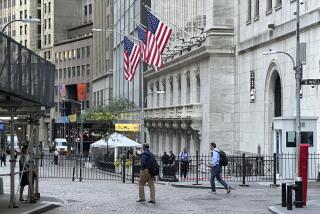Market Watch : Good Time for Industrials
- Share via
In an economy where recession supposedly still is a 50-50 possibility this year, industrial stocks are the last issues you’d expect to see rallying. Yet they have been some of the hottest stocks of late, in an otherwise struggling market.
The short explanation for strength in such stocks as heavy equipment makers Deere, Ingersoll-Rand, Tenneco and others is that there is no recession on the horizon for their products, regardless of what’s going on in the economy. Example: Ingersoll, whose best-known products are industrial air compressors (you see them wherever there’s highway work), had fourth-quarter earnings of $1.22 a share, up 12% from a year earlier.
Many of these companies are benefiting from continuing good demand in the United States (the rebuilding of the infrastructure and the farm economy takes a lot of heavy equipment) and from strong foreign orders as well. Many industrial companies also boast healthy balance sheets with little debt, a tribute to their painful restructurings of the ‘80s. On Wall Street these days, rising earnings and low debt are siren calls for weary investors. “Those two things attract a lot of people,” said analyst Charles Harris at Oppenheimer & Co.
Investors may also be taking a longer-term view, realizing that we’re entering a new spending cycle worldwide for industrial equipment, after the ‘80s near-depression. Plus, most of the stocks still appear reasonably priced. Farm equipment king Deere, for example, sells for 11 times the $6.25 a share it should earn this year. In contrast, the price/earnings ratio of the Standard & Poor’s 500-stock index is 13 1/2 times to 15 times estimated 1990 earnings, depending on whose estimate you believe.
Of course, P/Es of industrial stocks have historically been below the market average, because the companies are prone to boom-and-bust cycles. Even the biggest fans of the stocks are hesitant to suggest that their P/Es will rise dramatically.
Still, some analysts say the earnings power of many industrial firms in the ‘90s guarantees that the stocks have much further to rise, even if the P/Es just stay level. Tobias Levkovich, analyst at Smith Barney, Harris Upham & Co., believes that Caterpillar’s earnings will soar in the ‘90s, after an expected dip to $4.35 a share this year because of weakness in the U.S. truck market.
He sees Cat earning $6 a share in 1991 and $12 by 1995. Cat has committed $2.3 billion to make sure that its plants worldwide can compete with all comers in the ‘90s, Levkovich said, and “the benefits of that program will begin to exceed the costs in 1991.” What’s more, his profit estimates don’t include a possible boost from East European demand for earthmoving equipment, he said.
HOT INDUSTRIAL STOCKS
Yr. to date Stock Fri. % rise P/E* Clark Equip. $43 3/4 +19 10 Deere 69 7/8 +14 11 Trinova 27 3/4 +13 11 Ingersoll-Rand 55 1/2 +10 13 W.W. Grainger 71 1/8 +10 16 Tenneco 67 +8 15 Illinois Tool 47 7/8 +7 14 Caterpillar 62 1/8 +7 13
* Stock price/earnings ratios based on estimated 1990 earnings per share (Value Line Investment Survey estimates)
More Junk Woes: Junk bond mutual fund investors are finding that their troubles are still growing: Fund share prices continue to sink, despite a supposed stabilizing of junk bond prices, and a growing number of funds are slashing monthly dividends.
The payout cuts may be the unkindest of all. Generally, bond funds strive to keep their monthly payouts level, because steady income is important to many investors. But the decline of junk bond values has forced more funds to cut payouts, according to a study by fund research firm Kanon Bloch Carre & Co. in Boston.
Kanon estimates that 40% of junk funds cut their dividends in the three months ended Jan. 31. In contrast, “almost none had done so in the previous 18 to 24 months,” said Tyler Jenks, Kanon’s research director.
Fund managers are cutting dividends for several reasons, Jenks said: More bonds are in default, so funds are receiving less interest; fund managers are writing off the chance of earning interest on bonds viewed as default candidates, and for safety, most funds have raised the percentage of assets kept in lower-yielding short-term investments.
A drop in the monthly per-share dividend from, say, 8.8 cents to 7.8 cents might seem small, but that’s an 11% cut. Worse, Jenks sees dividends falling another 15% before junk defaults bottom.
True, many junk fund holders are still earning double-digit yields, even with the dividend cuts. But in the meantime, their share values keep sinking, even though junk bond traders insist that prices of the actual bonds have stabilized in recent weeks.
One possible explanation for the discrepancy: Fund managers may be taking a very conservative view of junk bond pricing, marking values lower in their portfolios to err on caution’s side. At some point, a bottom will be reached. When is anyone’s guess.
JUNK FUND PAYOUTS CUT
Monthly per-share payout Fund Previous Now Alliance Hi. Yld. 8.8 7.8 IDS Extra Income 4.4 3.5 Phoenix Hi. Yld. 8.5 7.3 Shearson Hi. Yld. 18.5 17.0 United Hi. Income 12.6 11.3
Source: Kanon Bloch Carre & Co.
Briefly: With Friday’s 24.77-point rally, the Dow Jones industrials closed at 2,660.36. On four separate attempts in mid-February, the Dow failed to breach 2,660, so Friday’s close could portend a further rally. Still, most analysts believe that the broad market will go lower by spring.
More to Read
Inside the business of entertainment
The Wide Shot brings you news, analysis and insights on everything from streaming wars to production — and what it all means for the future.
You may occasionally receive promotional content from the Los Angeles Times.










